debate 英文辩论赛流程:English
- 格式:docx
- 大小:21.88 KB
- 文档页数:4
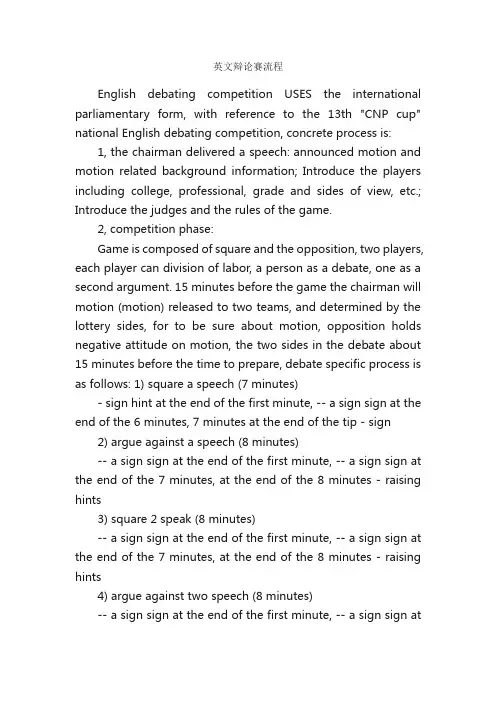
英文辩论赛流程English debating competition USES the international parliamentary form, with reference to the 13th "CNP cup" national English debating competition, concrete process is: 1, the chairman delivered a speech: announced motion and motion related background information; Introduce the players including college, professional, grade and sides of view, etc.; Introduce the judges and the rules of the game.2, competition phase:Game is composed of square and the opposition, two players, each player can division of labor, a person as a debate, one as a second argument. 15 minutes before the game the chairman will motion (motion) released to two teams, and determined by the lottery sides, for to be sure about motion, opposition holds negative attitude on motion, the two sides in the debate about 15 minutes before the time to prepare, debate specific process is as follows: 1) square a speech (7 minutes)- sign hint at the end of the first minute, -- a sign sign at the end of the 6 minutes, 7 minutes at the end of the tip - sign2) argue against a speech (8 minutes)-- a sign sign at the end of the first minute, -- a sign sign at the end of the 7 minutes, at the end of the 8 minutes - raising hints3) square 2 speak (8 minutes)-- a sign sign at the end of the first minute, -- a sign sign at the end of the 7 minutes, at the end of the 8 minutes - raising hints4) argue against two speech (8 minutes)-- a sign sign at the end of the first minute, -- a sign sign atthe end of the 7 minutes, at the end of the 8 minutes - raising hints5) argue against a summary (4 minutes)- sign hint at the end of the first minute, at the end of the third minute -- a sign up for, at the end of the fourth minute - raising hints6) square a summary (5 minutes)- sign hint at the end of the first minute, at the end of the fourth minute - sign hint, at the end of five minutes - raising hints Note for the game stage:In touch after the prompt, have 20 seconds to grace period, the speaker must be within this period to finish their speech, if more than grace period, the penalty points. If the speaker speech time is far less than the prescribed time, the jury regarded without unfold own viewpoint fully to the speaker.In 1-4, before the other party may appeal according to the speaker is argument put forward his own point of view (point of information, referred to as POI)The race stage questioner POI considerations:1) the POI to short and to the point, tact. It is strictly prohibited according to the rules of the game and personal questions; 2) to stand up from his seat, POI and hands. The questioner can use similar on that point, Sir/Madam speaker attention;3) the speaker can take the following ways to respond to the other party put forward POI: language refused (similar to Shanghai), accept questions (similar to "ok");4) if the POI's request to be accepted by the speaker, so POI statements have to clarify the facts or offer comments to form, the express in a sentence or two in 15 seconds; If you wererejected by the speaker so the questioner sat back and prepare the next question;5) POI can only be raised in the first four link, the last two links can't put forward, in the first four link within the first minute and can not be put forward in the last minutes POI;6) if the speakers accept POI, should according to questions and their speech to answer the question;POI, should put forward 7) unless otherwise not speak debater must not turn to stand up when others speak. If the opponent violation questions or disrupt the normal game rules, the player will be announced the foul;8) evaluate whether the POI put forward proper, should see its effect on both sides of the next debate9) the speaker in the speech must accept at least two POI, standing up questioners must be at least 4 times indicated the POI. Debater, if it does not have the opportunity to ask POI or in his speech did not accept the POI, the judges can discretionary points;3, audience member: the audience to sides each ask a question, select a player by both parties. The link at the end of the race, and increase the appreciation of the game, does not affect the result of the match.4, jury ruling: deliberations by a judge to review, submit to the chairman of the debate match results.1、主席致辞:宣布辩题及辩题相关背景资料;介绍选手包括学院、专业、年级及正反方所持观点等;介绍评委及比赛规则。
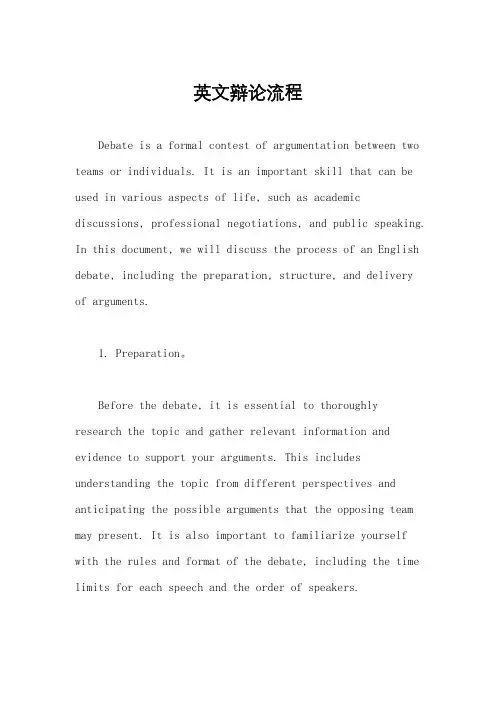
英文辩论流程Debate is a formal contest of argumentation between two teams or individuals. It is an important skill that can be used in various aspects of life, such as academic discussions, professional negotiations, and public speaking. In this document, we will discuss the process of an English debate, including the preparation, structure, and deliveryof arguments.1. Preparation。
Before the debate, it is essential to thoroughly research the topic and gather relevant information and evidence to support your arguments. This includes understanding the topic from different perspectives and anticipating the possible arguments that the opposing team may present. It is also important to familiarize yourself with the rules and format of the debate, including the time limits for each speech and the order of speakers.2. Structure。
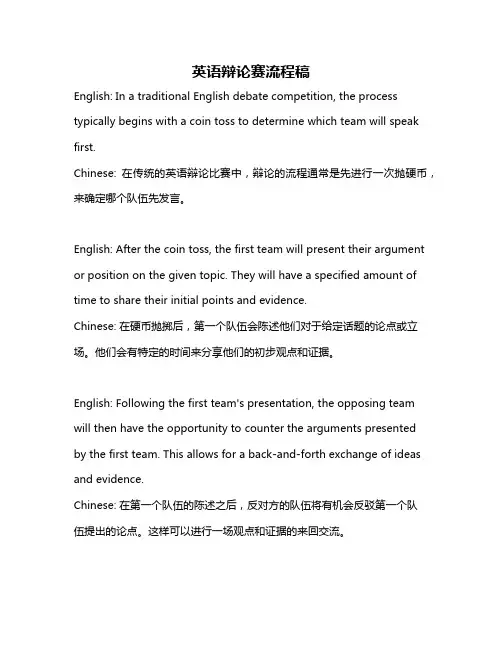
英语辩论赛流程稿English: In a traditional English debate competition, the process typically begins with a coin toss to determine which team will speak first.Chinese: 在传统的英语辩论比赛中,辩论的流程通常是先进行一次抛硬币,来确定哪个队伍先发言。
English: After the coin toss, the first team will present their argument or position on the given topic. They will have a specified amount of time to share their initial points and evidence.Chinese: 在硬币抛掷后,第一个队伍会陈述他们对于给定话题的论点或立场。
他们会有特定的时间来分享他们的初步观点和证据。
English: Following the first team's presentation, the opposing team will then have the opportunity to counter the arguments presentedby the first team. This allows for a back-and-forth exchange of ideas and evidence.Chinese: 在第一个队伍的陈述之后,反对方的队伍将有机会反驳第一个队伍提出的论点。
这样可以进行一场观点和证据的来回交流。
English: After both teams have presented their initial arguments and counter-arguments, there will often be a period of cross-examination. During this time, members of each team will have the opportunity to question the opposing team's points and evidence.Chinese: 在两个队伍都陈述了他们的论点和反驳后,通常会有一个交叉审问的时间。
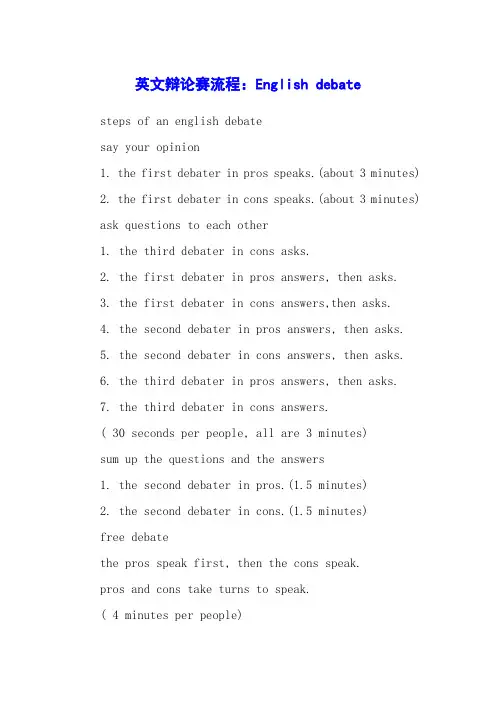
英文辩论赛流程:English debatesteps of an english debatesay your opinion1. the first debater in pros speaks.(about 3 minutes)2. the first debater in cons speaks.(about 3 minutes) ask questions to each other1. the third debater in cons asks.2. the first debater in pros answers, then asks.3. the first debater in cons answers,then asks.4. the second debater in pros answers, then asks.5. the second debater in cons answers, then asks.6. the third debater in pros answers, then asks.7. the third debater in cons answers.( 30 seconds per people, all are 3 minutes)sum up the questions and the answers1. the second debater in pros.(1.5 minutes)2. the second debater in cons.(1.5 minutes)free debatethe pros speak first, then the cons speak.pros and cons take turns to speak.( 4 minutes per people)sums up all the arguments1. the fourth debater in cons speaks.2. the fourth debater in pros speaks.( 4 minutes per people)rulesthe rules of asking partthe speach of each debater should includes answer part and ask part. the answer should be clear and easy and the question also should be clear.( only one question each time) the rules of free debate1. free debate should be around two teams.a debater in pros speaks first then a debater in cons speaks. two teams take turns, until the time is up.2. the time that each team takes should be calculated the total time. when one team end the speaking, we begin to record the time of the other team.3. in the total time. it doesn't matter that how long and how many times a debater speak.4. if one of the teams uses out the time, the other team can give up speaking or keep on taking turns until the time is up. giving up speaking cannot influence the score.during the debate, debaters cannot read theimformation that is prepared before. but they can show the summary of any newspaper or book.during the debate, debaters cannot leave sets. they also cannot stop the speaking of the other side debater or their side debater.。
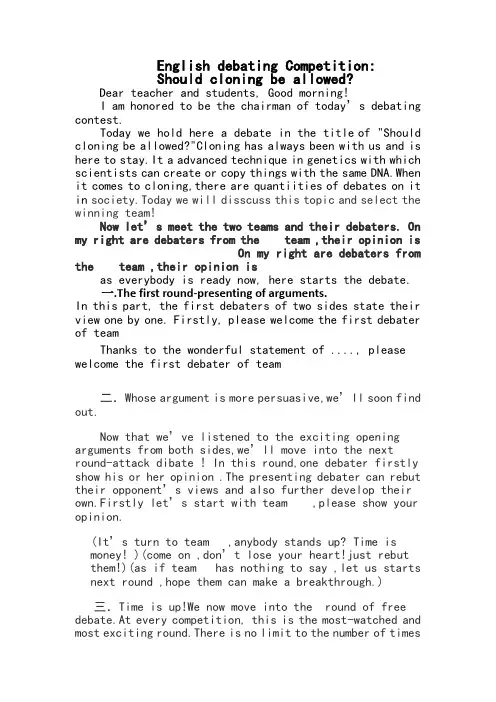
English debating Competition:Should cloning be allowed?Dear teacher and students, Good morning!I am honored to be the chairman of today’s debating contest.Today we hold here a debate in the title of "Should cloning be allowed?"Cloning has always been with us and is here to stay.It a advanced technique in genetics with which scientists can create or copy things with the same DNA.When it comes to cloning,there are quantiities of debates on it in society.Today we will disscuss this topic and select the winning team!Now let’s meet the two teams and their debaters. On my right are debaters from the team ,their opinion isOn my right are debaters from the team ,their opinion is as everybody is ready now, here starts the debate.一.The first round-presenting of arguments.In this part, the first debaters of two sides state their view one by one. Firstly, please welcome the first debater of teamThanks to the wonderful statement of ...., please welcome the first debater of team二.Whose argument is more persuasive,we’ll soon find out.Now that we’ve listened to the exciting opening arguments from both sides,we’ll move into the next round-attack dibate ! In this round,one debater firstly show his or her opinion .The presenting debater can rebut their opponent’s views and also further develop their own.Firstly let’s start with team ,please show your opinion.(It’s turn to team ,anybody stands up? Time ismoney! )(come on ,don’t lose your heart!just rebut them!)(as if team has nothing to say ,let us starts next round ,hope them can make a breakthrough.)三.Time is up!We now move into the round of free debate.At every competition, this is the most-watched and most exciting round.There is no limit to the number of timesdebaters can speak,nor the order in which they speake.Let’s invite the team to start.四.This round is quite exciting,but our debaters cannot relax.The conclusion round is also important.let’s start with team .五.This will be a close game .Every body try his best!Next ,let’s move into The audience question part!In this part, our audience could ask both teams some questions, each team need to answer questions from the audience. Who is the first one to ask question?( It sounds reasonable ,are you satisfied with it ? oh ,even if you say no ,I have to invited other audience,so sorry for you ~ )六.Time is up!This round is over,thanks for the audience and debaters. Their views all sound very nice, right? And I think you all have been well-prepared to win the competition.In conclusion,There are benefits such as cures for dis eases and disadvantages such as not perfecting the technique of cloning.Despite this fact,cloning will be an ongoing p rocess and will be tested.Hopefully cloning will not be a do wnfall to human history but rather a step closer to a better society.In this debate ,all the contestants have shown great debating ability in today's fierce competition. I'm sure we're all deeply impressed by the intelligent debaters. Thanks for your hard work and let's give ourselves a big round of applause.Now it's time for the result. Which contestants will win this wonderful debate? I am sure it is going to be very close. And I think all contestants need to be congratulated for their outstanding efforts.Let’ invite those audiences to make the winner!Those who support team raise your hands! The team!Let’s congratulate the team!!!The Competition has come to the end .Thanks for the all participating this Competition!thank you !。
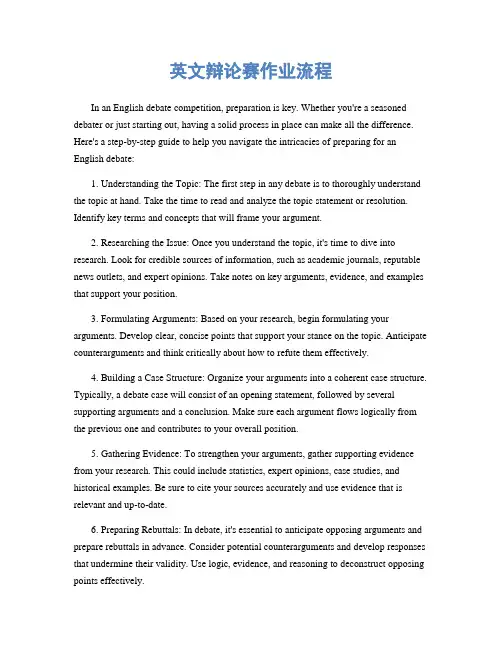
英文辩论赛作业流程In an English debate competition, preparation is key. Whether you're a seasoned debater or just starting out, having a solid process in place can make all the difference. Here's a step-by-step guide to help you navigate the intricacies of preparing for an English debate:1. Understanding the Topic: The first step in any debate is to thoroughly understand the topic at hand. Take the time to read and analyze the topic statement or resolution. Identify key terms and concepts that will frame your argument.2. Researching the Issue: Once you understand the topic, it's time to dive into research. Look for credible sources of information, such as academic journals, reputable news outlets, and expert opinions. Take notes on key arguments, evidence, and examples that support your position.3. Formulating Arguments: Based on your research, begin formulating your arguments. Develop clear, concise points that support your stance on the topic. Anticipate counterarguments and think critically about how to refute them effectively.4. Building a Case Structure: Organize your arguments into a coherent case structure. Typically, a debate case will consist of an opening statement, followed by several supporting arguments and a conclusion. Make sure each argument flows logically from the previous one and contributes to your overall position.5. Gathering Evidence: To strengthen your arguments, gather supporting evidence from your research. This could include statistics, expert opinions, case studies, and historical examples. Be sure to cite your sources accurately and use evidence that is relevant and up-to-date.6. Preparing Rebuttals: In debate, it's essential to anticipate opposing arguments and prepare rebuttals in advance. Consider potential counterarguments and develop responses that undermine their validity. Use logic, evidence, and reasoning to deconstruct opposing points effectively.7. Practicing Delivery: Once you have your arguments prepared, practice delivering them with confidence and conviction. Pay attention to your tone, pacing, and body language to ensure effective communication. Consider recording yourself or practicing in front of a mirror to fine-tune your delivery.8. Mock Debates: Finally, participate in mock debates to put your skills to the test. Engage with peers or mentors who can provide constructive feedback on your arguments and delivery. Use these opportunities to refine your approach and address any weaknesses before the actual competition.By following these steps, you can effectively prepare for an English debate competition and increase your chances of success. Remember to stay informed, articulate, and adaptable in your approach, and don't forget to enjoy the process of intellectual engagement and exchange.。
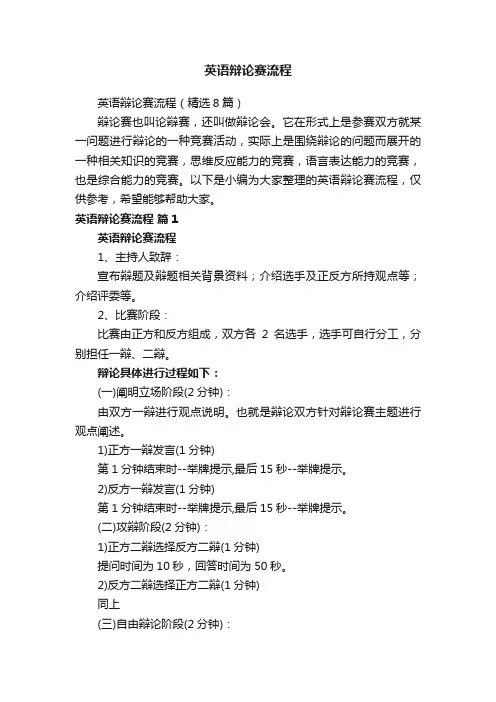
英语辩论赛流程英语辩论赛流程(精选8篇)辩论赛也叫论辩赛,还叫做辩论会。
它在形式上是参赛双方就某一问题进行辩论的一种竞赛活动,实际上是围绕辩论的问题而展开的一种相关知识的竞赛,思维反应能力的竞赛,语言表达能力的竞赛,也是综合能力的竞赛。
以下是小编为大家整理的英语辩论赛流程,仅供参考,希望能够帮助大家。
英语辩论赛流程篇1英语辩论赛流程1、主持人致辞:宣布辩题及辩题相关背景资料;介绍选手及正反方所持观点等;介绍评委等。
2、比赛阶段:比赛由正方和反方组成,双方各2名选手,选手可自行分工,分别担任一辩、二辩。
辩论具体进行过程如下:(一)阐明立场阶段(2分钟):由双方一辩进行观点说明。
也就是辩论双方针对辩论赛主题进行观点阐述。
1)正方一辩发言(1分钟)第1分钟结束时--举牌提示,最后15秒--举牌提示。
2)反方一辩发言(1分钟)第1分钟结束时--举牌提示,最后15秒--举牌提示。
(二)攻辩阶段(2分钟):1)正方二辩选择反方二辩(1分钟)提问时间为10秒,回答时间为50秒。
2)反方二辩选择正方二辩(1分钟)同上(三)自由辩论阶段(2分钟):时间是双方各2分钟。
由正反双方(四个辩手均可发言)自由轮流发言。
发言辩手落座为发言结束,同时另一方开始发言,另一辩手必须紧接着发言,若有间隙,累计时间照常进行。
同一方的发言次序不限。
如果一方用时已完,另一方可以继续发言,也可以向主持人提出不发言。
(四)讨论时间(2分钟):在讨论时间内,观众可向正反方各提一个问题,由双方选派一名选手作答。
该环节主要是增加比赛观赏性,不影响比赛结果。
(五)结辩陈词阶段(2分钟):由双方2辩进行结辩陈词。
也就是辩论双方针对辩论赛整体态势进行总结陈词。
1)反方2辩总结(1分钟)最后15秒--举牌提示。
2)正方2辩总结(1分钟)最后15秒--举牌提示。
3、主持人致辞:比赛结束。
英语辩论赛流程篇2选手及裁判在通知的时间或之前到达比赛场地,如因特殊原因不能参加,应提前告知负责人,在征得对手以及负责人的同意后可商议补赛时间。
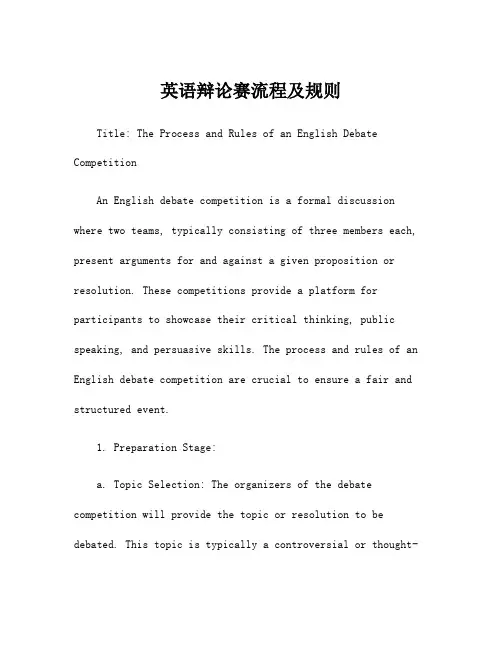
英语辩论赛流程及规则Title: The Process and Rules of an English Debate CompetitionAn English debate competition is a formal discussion where two teams, typically consisting of three members each, present arguments for and against a given proposition or resolution. These competitions provide a platform for participants to showcase their critical thinking, public speaking, and persuasive skills. The process and rules of an English debate competition are crucial to ensure a fair and structured event.1. Preparation Stage:a. Topic Selection: The organizers of the debate competition will provide the topic or resolution to be debated. This topic is typically a controversial or thought-provoking issue that allows for the presentation of different perspectives.b. Team Composition: Each team consists of three members, typically referred to as the first speaker, second speaker, and third speaker. These members work collaboratively to research the topic, develop arguments, and refine their presentation.c. Research and Argument Development: Teams extensively research the topic, gather relevant information, and formulate strong arguments to support their position. They also anticipate counterarguments from the opposing team and prepare rebuttals.d. Constructing the Debate Case: The teams organize their arguments, evidence, and rebuttals into a coherent and persuasive case. They strategize the order and timing oftheir speeches to maximize the impact of their arguments.2. The Debate Format:a. Opening Statements:i. Affirmative Team (First Speaker): The first speaker of the affirmative team presents the team's position and the key arguments supporting the resolution.ii. Negative Team (First Speaker): The first speaker of the negative team outlines the team's position and the main arguments against the resolution.b. Rebuttal Speeches:i. Affirmative Team (Second Speaker): The second speaker of the affirmative team responds to the arguments presented by the negative team and reinforces the affirmative case.ii. Negative Team (Second Speaker): The second speaker of the negative team challenges the arguments made by the affirmative team and presents the negative team's counterarguments.c. Cross-Examination:i. Affirmative Team (Third Speaker): The third speaker of the affirmative team questions the negative team, aiming to expose weaknesses in their arguments or uncover inconsistencies.ii. Negative Team (Third Speaker): The third speaker of the negative team questions the affirmative team, attempting to undermine their arguments or highlight flaws in their reasoning.d. Closing Statements:i. Negative Team (Third Speaker): The third speaker of the negative team summarizes the team's key arguments and provides a final rebuttal to the affirmative team's case.ii. Affirmative Team (Third Speaker): The third speaker of the affirmative team delivers a concluding statement, reinforcing the team's position and highlighting the strengths of their arguments.3. Judging and Scoring:a. Judging Criteria: The debate is typically judged by a panel of experienced adjudicators or judges who evaluate the teams based on specific criteria, such as:i. Argumentation: The strength, logic, and coherence of the arguments presented.ii. Refutation: The ability to identify and effectively respond to the opposing team's arguments.iii. Delivery: The clarity, fluency, and persuasiveness of the speakers' presentation.iv. Teamwork: The coordination and collaboration within the team.b. Scoring System: The judges assign points to each team based on their performance, with the team that accumulates the highest score being declared the winner.4. Principles of Ethical Debating:a. Respect for the Opposition: Debaters should maintain a respectful and professional attitude towards the opposing team, avoiding personal attacks or derogatory language.b. Truthfulness and Integrity: Participants are expectedto present factual information and arguments, refraining from the use of false or misleading statements.c. Fairness and Objectivity: Judges should strive to evaluate the teams impartially, basing their decisions solely on the merits of the arguments presented.d. Sportsmanship: Participants should demonstrate good sportsmanship, accepting the outcome of the debate gracefully, regardless of the result.5. Benefits of Participating in English Debate Competitions:a. Improved Communication Skills: Debating fosters the development of effective public speaking, active listening, and persuasive communication skills.b. Critical Thinking and Problem-Solving: The process of researching, analyzing, and formulating arguments encourages critical thinking and the ability to approach complex issues from multiple perspectives.c. Intellectual Stimulation: Engaging in debates exposes participants to diverse viewpoints and challenges them to think deeply about controversial topics.d. Confidence and Leadership: Successful participation in debates can boost individuals' confidence and leadership skills, as they learn to articulate their ideas effectively and think on their feet.e. Networking and Collaboration: Debating competitions provide opportunities for participants to connect with like-minded individuals, fostering networking and collaboration.In conclusion, the process and rules of an English debate competition are designed to create a fair, structured, and intellectually stimulating environment for participants to showcase their skills and engage in meaningful discussions. By following these guidelines, debaters can develop essential communication, critical thinking, and problem-solving abilities, which can be valuable assets in various personal and professional settings.。
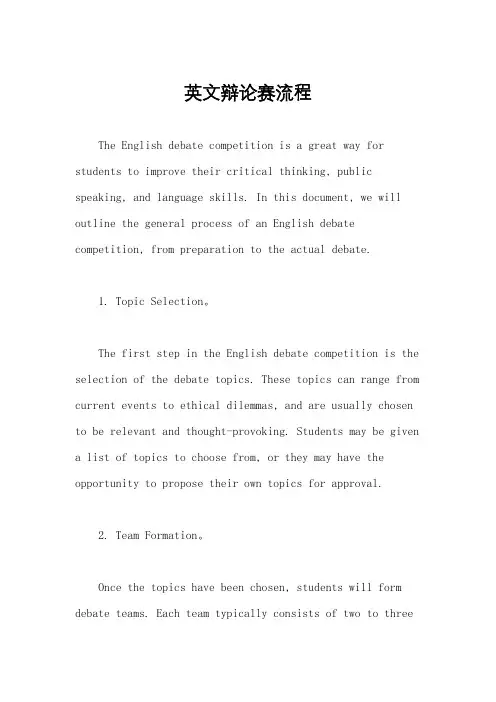
英文辩论赛流程The English debate competition is a great way for students to improve their critical thinking, public speaking, and language skills. In this document, we will outline the general process of an English debate competition, from preparation to the actual debate.1. Topic Selection。
The first step in the English debate competition is the selection of the debate topics. These topics can range from current events to ethical dilemmas, and are usually chosen to be relevant and thought-provoking. Students may be given a list of topics to choose from, or they may have the opportunity to propose their own topics for approval.2. Team Formation。
Once the topics have been chosen, students will form debate teams. Each team typically consists of two to threemembers, with one member designated as the lead speaker. It is important for the team members to work together cohesively and to allocate specific roles and responsibilities for each member.3. Research and Preparation。
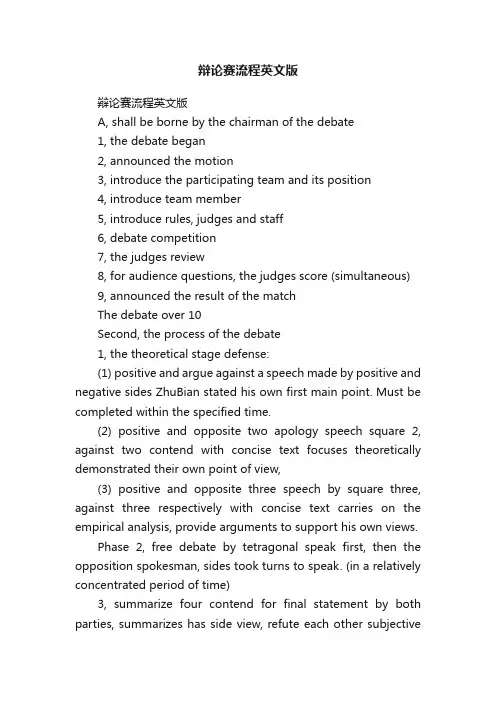
辩论赛流程英文版辩论赛流程英文版A, shall be borne by the chairman of the debate1, the debate began2, announced the motion3, introduce the participating team and its position4, introduce team member5, introduce rules, judges and staff6, debate competition7, the judges review8, for audience questions, the judges score (simultaneous) 9, announced the result of the matchThe debate over 10Second, the process of the debate1, the theoretical stage defense:(1) positive and argue against a speech made by positive and negative sides ZhuBian stated his own first main point. Must be completed within the specified time.(2) positive and opposite two apology speech square 2, against two contend with concise text focuses theoretically demonstrated their own point of view,(3) positive and opposite three speech by square three, against three respectively with concise text carries on the empirical analysis, provide arguments to support his own views.Phase 2, free debate by tetragonal speak first, then the opposition spokesman, sides took turns to speak. (in a relatively concentrated period of time)3, summarize four contend for final statement by both parties, summarizes has side view, refute each other subjectivepoint:(1) argue against four summation(2) square four summation4. Audience member: the audience to questions of both players, players must give the answer patiently. Stage performance is not recorded in the results of the competition between the two sides to ask a question.5, the judges scoring stage6, the judges review the process of both views and debate.7, the announcementThree, the rules of the debate1, each member must be finished within the prescribed period of time, over time, in accordance with abstained processing, and lose from team total score 5 points.2, free debate rules free debate speech must alternates between the teams, the first to speak with a member of tetragonal, then one by opposition players, the two sides take turns, until you run out of time. (each a free debate in the concentration of two hours to complete, what time each other, each stick words between 60-800 words, can only ask a question at a time.)Fourth, criteria(a) will be hired to review all the five judges of the game.(2) criteria1, point clear, argument is sufficient, citing appropriate, analyzed thoroughly.2, grabbed the other views and error, precedents and precise, and to the point.3, reflect agile, strong ability to deal with.4, articulate, level clear, tight logic.(3) the scoring method (group and individual scores respectively, out of 100)(1) the topic: can the logic, theory, from the position held by the fact that such as multi-level and multi-angle, argument is sufficient, reasoning is clear, whether for his own difficulties with effective treatment methods.(2) the argument: if there is a convincing argument, argument is sufficient, whether logical reasoning process, the fact whether the reference is proper, true.(3) dispute: to ask whether to grab the key, the problem simple. No questions or questions within the time required, should be appropriate. The question of whether or not to answer each other, can you give a person the sense with justified. Don't answer or not answer should be penalised accordingly.(4) : whether to have team spirit, mutual support, debate cohesion is closely. Whether q&a form an organic whole, to a powerful blow to the other party.(5) argue the wind: the language and debate style exquisite civility. Personal attacks will be made to argue each other friends and netizens.(4) points: every topic, argument, dispute, cooperate, argue the wind project, do not conform to the requirements of the evaluation and in violation of the rules, are appropriate. Due to the fault causes of incidents affect the game, is decided by the jury, in a 5-10% reduction of its cumulative total score.(5) score project group and individual points per game comparison table is as follows:(6) score project group and individual points per game of appraisal form(7) good debater respectively by the outcome of each racescores are the highest return. The game of "best debater" tired integral calculation by the individual scores the highest gain, formula is: the total integral/attend the session.(8) the outcome of judgment1, the outcome of the game, on the basis of a few judges play group points, remove the a and a minimum points, calculating the remaining points scored an average of judgement.2, debater individual scoring points calculation method, calculation method with groups only as an individual award review basis, has nothing to do with judging each outcome.Five, awards and incentives1, every game are selected each a good debater each team, will decide after the game one of the best debater.一、由辩论会主席承担。
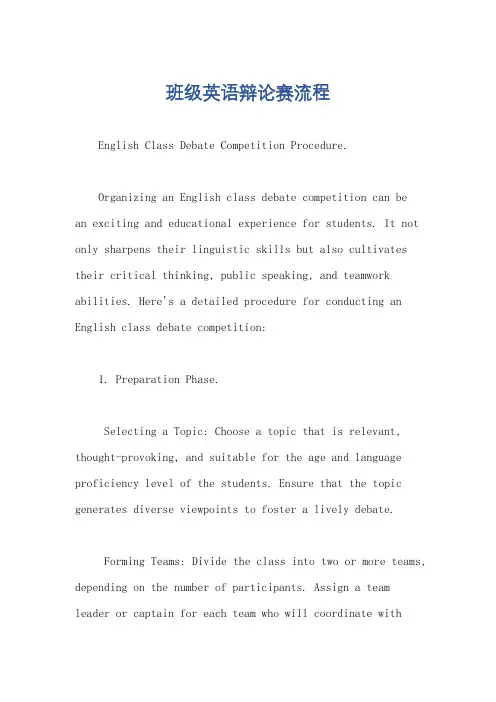
班级英语辩论赛流程English Class Debate Competition Procedure.Organizing an English class debate competition can bean exciting and educational experience for students. It not only sharpens their linguistic skills but also cultivates their critical thinking, public speaking, and teamwork abilities. Here's a detailed procedure for conducting an English class debate competition:1. Preparation Phase.Selecting a Topic: Choose a topic that is relevant, thought-provoking, and suitable for the age and language proficiency level of the students. Ensure that the topic generates diverse viewpoints to foster a lively debate.Forming Teams: Divide the class into two or more teams, depending on the number of participants. Assign a team leader or captain for each team who will coordinate withtheir team members.Research and Preparation: Provide students with sufficient time to research and prepare for the debate. They should collect evidence, facts, and arguments to support their viewpoints. Encourage them to use reliable sources and to cross-check information for accuracy.2. Opening Ceremony.Introduction: Begin the debate competition with abrief introduction about the topic, the purpose of the debate, and the rules of the competition.Welcome Speech: Deliver a warm welcome speech to the participants, judges, and audience, thanking them for their presence and support.3. The Debate.Opening Statements: Each team presents its opening statement, outlining their position on the topic and themain arguments they will present during the debate.Main Debate: The main debate consists of rounds of speaking, usually alternating between the teams. Each team presents its arguments and counters the opponent's points. The judge moderates the debate, ensuring that all participants adhere to the rules and have equal opportunities to speak.Rebuttal: After the main debate, there is usually a rebuttal round where each team has the opportunity to respond to the arguments presented by the opposing team.Closing Arguments: Each team presents its closing arguments, summarizing their key points and restating their position on the topic.4. Judge's Decision.Deliberation: After the debate, the judges deliberate to determine the winner. They consider various factors such as the quality of arguments, clarity of expression, and theeffectiveness of rebuttals.Announcement: The judge announces the winner andrunner-up, providing feedback and suggestions to all participating teams.5. Closing Ceremony.Awards Ceremony: Award certificates or trophies to the winning team and any outstanding individual performers. Also, consider awarding participation certificates to all participants.Thank You Speech: Deliver a closing speech thankingall participants, judges, and audience members for their participation and support.6. Post-Competition Activities.Debriefing: Conduct a debriefing session with the participating teams to discuss their experiences, learnings, and areas for improvement.Feedback: Provide feedback to the teams on their performance, highlighting strengths and areas for improvement. Encourage them to use this feedback in future debates.Organizing an English class debate competition requires careful planning and execution. It's essential to provide clear instructions, set clear expectations, and create a supportive learning environment. By following the above procedure, you can ensure a smooth and enjoyable debate competition that benefits all participants.。
班级辩论会的流程英文版Debate competitions are essential activities that provide students with the opportunity to express their opinions, improve their critical thinking skills, and develop their public speaking abilities. The process of a class debate typically involves several key stages.Firstly, the topic for the debate is selected, and students are divided into teams, with each team assigned a specific stance to either support or oppose the topic. This step is crucial as it allows students to thoroughly research and understand the topic from different perspectives.Secondly, the teams are given time to research and prepare their arguments. This involves conducting thorough research, gathering evidence, and formulating strong points to support their stance. It also requires students toanticipate counterarguments and prepare responses to effectively defend their position.Next, the debate takes place with each team taking turns to present their arguments and counterarguments. This stage allows students to practice their public speaking skills and learn how to effectively communicate their ideas to an audience. It also encourages active listening as students must pay attention to the opposing team's arguments in order to formulate rebuttals.Following the presentations, a period of cross-examination may occur, where teams have the opportunity to question each other's arguments. This encourages critical thinking and the ability to think on one's feet, as students must respond to unexpected challenges from the opposing team.Finally, the debate concludes with a closing statement from each team, summarizing their key points and reinforcing their stance on the topic. This allows students to practicepersuasive speaking and solidify their arguments in the minds of the audience.Overall, the process of a class debate provides students with valuable opportunities to enhance their critical thinking, public speaking, and communication skills. It fosters an environment of intellectual engagement and encourages students to engage with diverse perspectives on important issues.。
国才杯英语辩论赛流程The National Talent Cup English Debate Competition ProcessThe National Talent Cup English Debate Competition is a prestigious event that showcases the linguistic prowess and critical thinking abilities of students from across the country. The competition is divided into several stages, each designed to challenge and refine the participants' debating skills. This comprehensive process ensures that the most deserving individuals emerge as the champions, leaving a lasting impression on both the audience and the judges.The first stage of the competition is the preliminary round, where teams of two students engage in a series of debates on pre-determined topics. These topics are carefully selected to cover a wide range of social, political, and ethical issues, challenging the participants to research thoroughly, formulate compelling arguments, and effectively communicate their ideas. During this phase, the teams are evaluated based on their ability to present clear and logical arguments, respond to counterarguments, and maintain a professional and respectful demeanor.The preliminary round serves as a crucial filter, separating thestrongest teams from the rest. Only the top-performing teams are then invited to the quarterfinal round, where the competition becomes even more intense. In this stage, the teams are presented with new topics, often more complex and nuanced, requiring them to think on their feet and adapt their strategies accordingly. The judges closely observe the teams' ability to think critically, anticipate their opponents' lines of reasoning, and deliver their arguments with eloquence and conviction.Advancing from the quarterfinals to the semifinals is no easy feat, as the level of competition reaches new heights. The semifinal round is where the true champions begin to emerge. The teams are now required to engage in a series of cross-examinations, where they must not only present their own arguments but also effectively challenge and rebut the opposing team's positions. The ability to think critically, ask insightful questions, and maintain composure under pressure becomes crucial at this stage.The final round of the National Talent Cup English Debate Competition is the culmination of the entire event. The two finalist teams take the stage, facing off in a high-stakes battle of wits and rhetoric. The topics presented in the final round are designed to push the participants to their limits, testing their comprehensive understanding of the issues and their ability to construct and deliver their arguments with the utmost precision and persuasiveness.Throughout the competition, the teams are evaluated not only on the content of their arguments but also on their delivery, organization, and overall communication skills. The judges, who are experts in the field of debate and public speaking, provide detailed feedback to the participants, helping them identify areas for improvement and guiding them towards greater success in future competitions.The National Talent Cup English Debate Competition is not just about winning or losing; it is about the journey of self-discovery and growth that each participant embarks upon. The process of preparing for and participating in the competition instills valuable skills that extend far beyond the realm of debating. Critical thinking, effective communication, teamwork, and the ability to think on one's feet are all essential life skills that the participants develop and hone throughout the competition.Moreover, the competition serves as a platform for cultural exchange and mutual understanding. Participants from diverse backgrounds come together, sharing their unique perspectives and experiences, and learning from one another. This cross-pollination of ideas not only enriches the competition but also fosters a greater appreciation for diversity and inclusivity.In conclusion, the National Talent Cup English Debate Competition is a remarkable event that showcases the best and brightest minds in the country. The comprehensive process of the competition, from the preliminary rounds to the final showdown, is designed to challenge and nurture the participants' debating skills, critical thinking abilities, and overall communication prowess. The journey towards the championship is not just a test of academic excellence but also a testament to the participants' resilience, dedication, and passion for the art of debate. Through this competition, the future leaders of our society are forged, ready to tackle the complex challenges of the world with confidence and conviction.。
英语辩论赛流程及时间English: In an English debate competition, the typical format and time allocation vary slightly depending on the level of the competition and the specific rules set by the organizers. Generally, a debate consists of multiple rounds, with each round lasting around 60 to 90 minutes. The debate begins with the introduction of the motion or topic by the moderator or adjudicator. Following this, each team is given a set amount of time, usually around 5 to 10 minutes, to present their arguments for or against the motion. This is typically followed by a period of rebuttals, where teams have the opportunity to directly respond to the arguments presented by the opposing side. Rebuttals are usually shorter, lasting around 3 to 5 minutes per team. After the main arguments and rebuttals, there may be a cross-examination period where members of each team can question the other side to further clarify their points or challenge their arguments. Finally, the debate concludes with closing statements from each team, summarizing their key points and reinforcing their stance on the motion. The length of these closing statements is usually similar to the opening statements, around 5 to 10 minutes per team. Throughout the debate, judges or adjudicators evaluate the teamsbased on criteria such as argumentation, presentation skills, teamwork, and responsiveness to the opposing side's arguments.Translated content: 在英语辩论比赛中,典型的格式和时间分配根据比赛的水平和组织者设定的具体规则略有不同。
英语辩论赛流程稿Ladies and gentlemen, distinguished judges, fellow debaters, and esteemed audience members,。
Today, we gather here for an English debate competition, where we will engage in a battle of wits and ideas. The purpose of this event is not only to showcase our English language skills but also to foster critical thinking and effective communication. In this article, we will outline the process of an English debate competition, from the preparation stage to the final round.First and foremost, before the actual debate takes place, teams are formed, and topics are assigned. Each team consists of three members: the first speaker, the second speaker, and the third speaker. These teams are given ample time to research and gather evidence to support their arguments. It is crucial for debaters to thoroughly understand the topic and be well-versed in both the pros and cons of the issue at hand.Once the preparation stage is complete, the competition begins. The first round is the opening statements. Each team is given a specific amount of time to present their arguments and introduce their stance on the topic. The first speaker plays a vital role in setting the tone for the debate, as they need to capture the audience's attention and establish credibility.Following the opening statements, the debate moves into the second round, which is the cross-examination round. In this phase, the second speaker from each team has the opportunity to question the opposing team. This round allows for clarification of arguments and exposes any weaknesses in the opposing team's position. It requires quick thinking and the ability to respond effectively under pressure.After the cross-examination round, the debate progresses into the third round, which is the rebuttal round. Here, the third speaker from each team presents counterarguments to the opposing team's claims. The goal is to dismantle the opponent's arguments andstrengthen their own position. The third speaker must be persuasive and provide compelling evidence to support their case.As the debate reaches its final stage, the fourth round, it is time for the closing statements. Each team's second speaker delivers a concise summary of their main points and reinforces their stance on the topic. This round is crucial in leaving a lasting impression on the judges and audience members.Following the closing statements, the judges deliberate and evaluate the performance of each team. They consider factors such as clarity of arguments, organization, evidence, and overall persuasiveness. The team with the highest score is declared the winner of the debate competition.In conclusion, an English debate competition is a platform for students to showcase their language skills, critical thinking abilities, and persuasive communication. It requires thorough preparation, effective teamwork, and the ability to think on one's feet. By participating in such events, students not only improve their English proficiency but also develop essential skills that will benefit them in various aspects of life. So, let us embrace the spirit of healthy competition and engage in thought-provoking debates that will broaden our horizons and shape our perspectives. Thank you.。
英语辩论赛Goodmorningeveryone,welcometothe EnglishDebating Competition.I'm honored to be nominated the monitor for today's debating topic for our debate today is “Can man triumph over nature”First ,please let me introduce the judge and the contestants of both sides.The judge and staff is ;;;;Those on the pros are ;;;;;;;.They feels justified in holding the belief that the man can conqur nature. Those on the cons are ;;;;;;;.They argues that forces of nature are irresistible.Ok,let'sgiveourdebatersthisargument. Therearefourphasesinthisdebate,makingapoint , askingandreplyingquestions ,freedebate, lastsummary.1、Now,l et’scometothefirststage,theopeningstatement. Duringthisstage,debaternumber1ofbothsidesshouldgiveano peningstatement.Eachdebaterhas2minutes.Whentimeisup,ourstaffwillshowyoubyawhistle.Debaternumber1ofaffirmativeside,areyoureadyTimebegins.some people think that man can conquer nature . just atnow ,humans can predict the weather forecast ,when the drought in some areas , we can use the artificial rainfall to reduce losses .The more great is humans can survive in extremely bad enviroment , such as the polar regions.Timeisup,thankyou.Debaternumber1ofnegativeside,areyoureadyTimebegins.Thank you Nowadays nature disasters really bring a great damage to human beings, however, how can we leave it as it is First, we should fighting in the face of nature disasters as we fighting with our enemies.Second, most of the disasters have their signs, so we can complete the defensive preparation work before they come.Third, sometimes the disasters are inevitable, but we can do the most we can to reduce the losses.Forth, now science and technology become so advanced that we can make great achievements both in disaster prevention and reconstruction after the disaster.Fifth, as we know, many nature disaster have already been well controlled with the developing of science and technology, so we believe that we can conquer and change nature based on science and technology.Timeisup,thankyou.Thanksfordebaternumber1ofbothsides.2、Askingandreplyingquestions:Eachdebaterhas1minutesNow,let’s cometothesecondstage.Duringthisstage, debaternumber2ofbothsidescanraisequestions concerningtoeachother’sopeningstatement.Eachdebater has 2minutes.Debaternumber2ofaffirmativeside,areyouready Timebegins.Timeisup,thankyou.Debaternumber2ofnegativeside,areyoureadyTimebegins.Timeisup,thankyou.Thanksfordebaternumber2ofbothsides.3、freedebate.Itistimeforustoenterthemostexcitingpart,freedebate. Duringthisstage,timeis 4minutes.Debatersofbothsidescan raisequestionstotheother’sstatement.Eachsidehas2minut es.Ifyourtime’sup,youcannotanswerquestionsoraskquestions anymore.Ourstaffwillshowyoubyawhistlewhenyourtime’s up.Debatersofaffirmativeside,areyoureadyTimebegins.Timeisup,thankyou.4、Lastsummary:Afterthefiercefreedebate,wearecomingtothelaststage, closingstatement.Inthispart,one ofbothsidescansummarize yourownopinion.Eachdebaterhas1minutes.Whentimeisup,our staffwillshowyoubyawhistle.Let’sbeginwithdebater ofnegativeside,areyoureadyTime begins.Timeisup,thankyou.Debaterofaffirmativeside,areyoureadyTimebegins.Timeisup,thankyou.ThankeverydebaterTheir views all sound very nice, right And I think you all have been well-prepared to defeat the other let’s listen to the judge’s comment.ever since humanbeings come into being, we had never stopped the action to put our feet on each inch of land we can find. we fight against nature, at first, for survival. our nation buildup the reservoir for not only preventing flood but also generating electricity. this well proved that we can conquer nature and make it serve us better. secondly, some people taking fighting against nature as a challenge of life, a way to gain honor. the climbing of everest will be an exact instance here. however, nature has never give up trying to give man a lesson now and then. the earthquake of tang shan china in 1976 and the ground sea of india in 2004, nature reminded us of her unconquerable power by unanswerable facts.now, as you can see, we have the problem, it seems that we have never triumph over nature as nature did to us. when it is hard to draw a conclusion, dialectic is in favor of us. contradictory evidence requires us think about the question dialectic. then we get it. neither man or nature can triumph over each other. if we go our own way shortsightedly, we will finally reap as we have sown: worse crisis of resource, worse pollution of invironment.so brightly future just depends on a harmonious relationship with nature.All the contestants have shown great debating ability in today's fierce competition. I'm sure we're all deeply impressed by the intelligent debaters. Thanks for your hard work and let's give ourselves a big round of applause. Now it's time for the result. Which contestants will win this wonderful debate And who will be the best debater today I am sure it is going to be very close. And I think all contestants need to be congratulated for their outstanding efforts.。
一、辩论赛程序(由主席执行)English debating competition1、开场白2、队员入场,介绍参赛队及其所持立场,介绍参赛队员,介绍评委及其点评嘉宾3、比赛开始4、评判团入席,点评嘉宾评析赛事5、宣布比赛结果(包括最佳辨手)二、辩论程序(正反方)正方:pro side 反方:con side1、陈词阶段正方一辩发言(三分钟)the first debater of pro side反方一辨发言(三分钟)the first debater of con side2、盘问阶段(1)反方三辩提问third debater(2)正方一辩回答、提问first debater(3)反方一辩回答、提问(4)正方二辩回答、提问second debater(5)反方二辩回答、提问(6)正方三辩回答、提问(7)反方三辩回答(每人30秒,共3分钟)盘问总结正方二辨(1分30秒)反方二辨(1分30秒)3、自由辩论阶段由正方首先发言,然后反方发言,正反方依次轮流发言。
(各四分钟)4、总结阶段反方四辩总结陈词(四分钟)正方四辩总结陈词(四分钟)规则1、盘问规则(1)每个队员的发言应包括回答与提问两部分。
回答应简洁,提问应明了(每次提问只限一个问题)。
(2)对方提出问题时,被问一方必须回答,不得回避,也不得反驳。
2、自由辩论规则(1)自由辩论发言必须在两队之间交替进行,首先由正方一名队员发言,然后由反方一名队员发言,双方轮流,直到时间用完为止。
(2)各队耗时累计计算,当一方发言结束,即开始计算另一方用时。
(3)在总时间内,各队队员的发言次序、次数和用时不限。
(4)如果一队的时间已经用完,另一队可以放弃发言,也可以轮流发言,直到时间用完为止。
放弃发言不影响打分。
3、辩论中各方不得宣读事先准备的稿件或展示事先准备的图表,但可以出示所引用的书籍或报刊的摘要。
4、比赛中,辩手不得离开座位,不得打扰对方或本方辩手发言。
debate 英文辩论赛流程:English
Steps of an English debate
say your opinion
1.The first debater in pros speaks.(about 3 minutes)
2.The first debater in cons speaks.(about 3 minutes)
frankly speaking,at first i had some difficulty following the teachers.however,through my own efforts and thanks to my teachers’guidance,i made remarkable progress.now i’ve benefited a lot from lectures and many other academic reports.
ask questions to each other
1.The third debater in cons asks.
2.The first debater in pros answers,then asks.
3.The first debater in cons answers,then asks.
4.The second debater in pros answers,then asks.
5.The second debater in cons answers,then asks.
6.The third debater in pros answers,then asks.
7.The third debater in cons answers.
注:根据各组情况,如果各组实力均衡并较强,获胜的两组进入决赛,不对辩手进行调动;如果获胜组中有辩论能力较弱的人,挑出前8名进入决赛。
(30 seconds per people,all are 3 minutes)
sum up the questions and the answers
1.The second debater in pros.(1.5 minutes)
2.The second debater in cons.(1.5 minutes)
free debate
The pros speak first,then the cons speak.
Pros and cons take turns to speak.
(4 minutes per people)
比赛期间,评委将对发言进行现场评点,其余不参与比赛的同学也可以在指定的讨论区域发表自己的观点,或者为自己喜欢的参赛队伍加油、呐喊;
sums up all the arguments
The time that each team takes should be calculated the total time.When one team end the speaking,we begin to record the time of the other team.
主席致辞:宣布辩题及辩题相关背景资料;介绍选手包括学院、专业、年级及正反方所持观点等;介绍评委及比赛规则。
1.The fourth debater in cons speaks.
2.The fourth debater in pros speaks.
9)发言者在发言时须至少接受2次POI,提问者至少要站起4次示意提POI。
辩手若没有抓住机会提POI或者在发言中没有接受POI,评委可酌情扣分;
(4 minutes per people)。